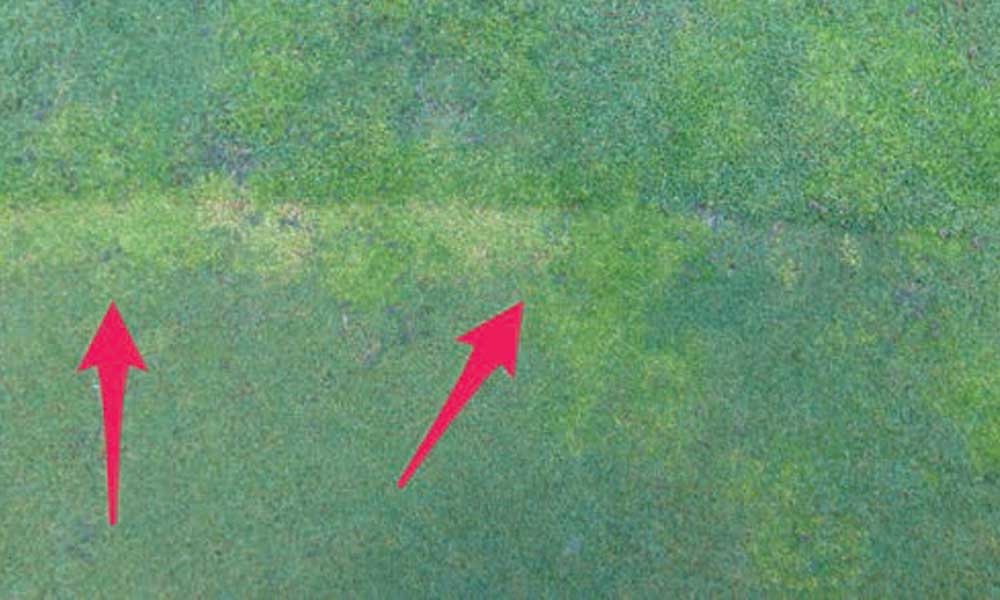Over the years at Glen Echo I’ve heard many ask about the poa on our greens. Some think it’s gone away. Our poa has not gone away. Poa annua is a part of all of our putting surfaces. In 1995 when the putting surfaces were gassed and grassed with a blend of Cato/Crenshaw Bent grass, there was not any poa. 20 years later, we have greens that average 20% with some as high as 50% or more. We’ve made efforts to reduce the amounts over the last 7 years since I have been here. Some years it seems like we take 2 steps ahead and other years we take 3 steps back. The poa right now on the greens has a tendency to be a lighter/lime green looking color with a seed heads interspersed. In most cases instead of large patches of poa annua without any bent grass, we now have both bent and poa spread throughout the greens.
A course that has been around for 114 years like Glen Echo can have many different species of poa both annual varieties as well as perennial. As you can see now in some areas of the rough, poa annua is seeding profusely. We are right in the middle of what is called the seed head flush. Pretty simple explanation is poa annua plants are in full bloom right now. This is charted using Growing Degree Day Models which help to time applications for weed and insect control.
Overall, we’ve had pretty good timing on our greens and our efforts to reduce seed head production. Primo/Proxy has been my products that I have used over the years at Glen Echo. This is one reason why many have difficulty seeing the poa on the greens because we reduced the negative impacts that plants can make on ball roll and have reduced the overall seed head production on our greens. We’ve not eliminated seed heads by any stretch but it has improved. This season has seemed to be one of our best since I’ve been at Glen Echo.
Factors we continue to fight here at Glen Echo when it comes to reducing the amount of poa annua on our greens include.
• Greens have not been grassed since 1995. Most clubs in the district have grassed since then and some have done it twice. This is not an option at this time. The course cannot close from September to May/June the next season. A number of clubs in town were able to renovate greens due to large scale MSD projects which helped fund improvements. Some also grassed before the economic downturn in 2008.
• The variety grasses we have now were developed in the 80’s and probably have 25-50% less grass plants per square foot then the new varieties. The tight turf does help to reduce poa from over taking a green.
• Greens have no drainage except natural flow besides #9 which was rebuilt in the late 80’s. Installing drainage using a technique by a few contractors in the country can cost $ 7-10,000 per green. It does improve playability, dries quicker and can reduce poa stranglehold with drier conditions.
• Trees which cause shade and reduce air movement keeping greens wetter longer.
• No fans on greens. Air movement helps in drying greens which poa annua does not appreciate. At least 6-8 greens on the course could use a fan. $7,000 per fan plus the electric to install which could double the cost per green.
• Poa population, seed bank on a 114 year old course. Using some products on the market with the percentage of poa annua on our greens could lead to massive turf loss. Newer grassed facilities can use these chemicals because their percentages of poa annua are so much smaller.
So what is a guy to do if we cannot actually make any major changes to infrastructure at this time?
• Improve and expand knowledge to combat issues regarding our greens.
• Provide proper cultural practices to our greens, i.e. fertilization, water, aeration, disease management, and many other factors to encourage bent and discourage poa.
• Add newer varieties of bent grass in the fall with seeding. Called inter seeding, some advances are made but it is not easy with greens being kept at normal cutting height and fall weather having a tendency to be dry which does not encourage baby plants at 1/10 of an inch to stay alive.
• Continue to use growth regulators to keep poa annua in check or reduced if conditions are right. Paclobutrazol has been my main fall/spring product(3 times in fall up to 16 oz and 3 times in spring with last at 8 oz). I use Primwo in summer. Don’t have large enough bullocks to keep the Paclo going in the summer.
• As the financial climate improves, contract drainage installation to our worst greens.
• I’ve left this for last but remove trees that are creating excessive shade to green sites. East and southern exposure trees are the enemy to all of us because they suck the life out of our greens. They reduce sunlight in the morning and mid-day and if sunlight is reduced you are guaranteed to have a reduction in air movement across the green surface. Scientists says wind speeds of 4 MPH or more are needed to allow the plant to open its stomata’s which allows the plant to exchange gases, reduce moisture and heat buildup in the plant by encouraging its processes such as respiration and food production to occur.(simplified version) Lack of plant processes leads to energy reduction, heat stress and senescence of leaves.(physiological decline, death)





















